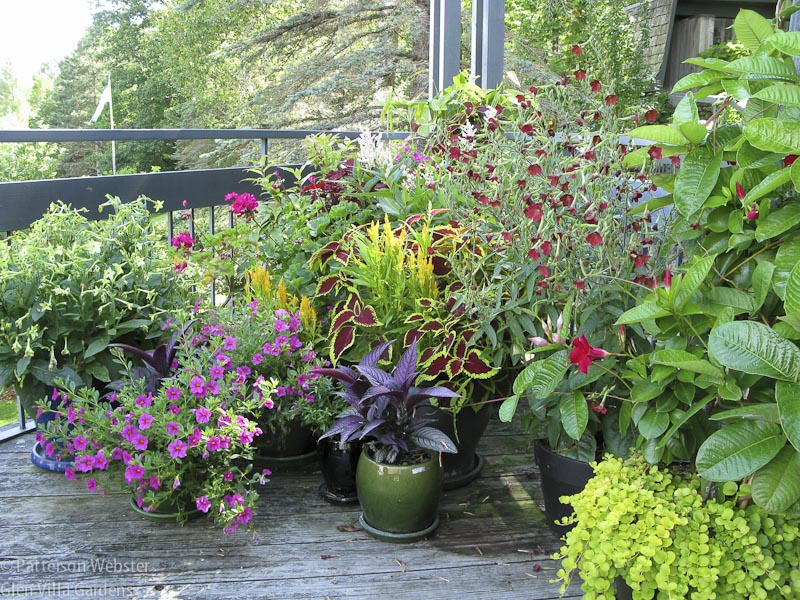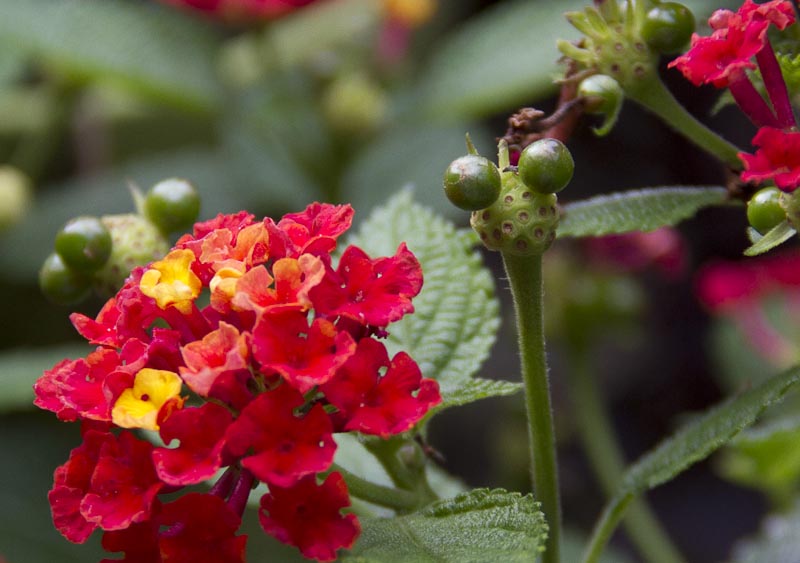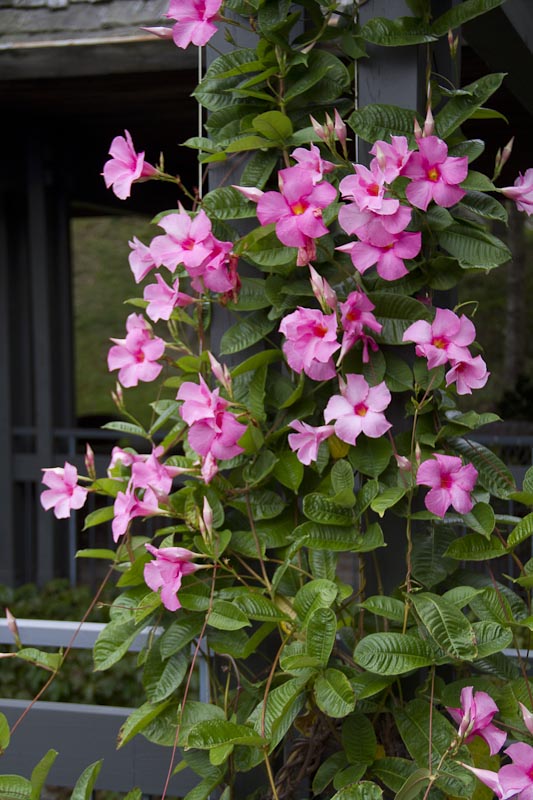A common principle of garden design states that the style of a house should be mirrored in the style of the garden. A Georgian brick house is most comfortable surrounded by a symmetrical garden, a country cottage by loose and flowing borders. While this ‘rule’ is not iron-clad and exceptions can be successful if skillfully done, ignoring the architecture of the house when planning a garden just isn’t smart.
I believe the same principle applies to container gardening. The style of the plants, the containers that hold them, their placement and arrangement need to fit the architecture of the house.
Glen Villa is a contemporary house built using natural materials. Constructed in the late 1960s, the house was conceived in the spirit of the times — and that makes it a bit wonky.

This view of the house shows the barnboard siding, the cedar-shingled roof, the round chimneys and the peculiar ‘eyebrows’ over the windows.
Built on a hillside, the house is surrounded by decks, three of which are shown in the picture above. All of the decks are above ground and some jut out into space, ending in sharp points. This is unusual, to say the least.

This is the only photo I have of this deck without furniture. You’ll have to ignore the inverted branches on the deck; they were part of an exhibition I mounted a few years ago.
These sharp points create difficulties, both in relation to the placement of furniture and to the choice and arrangement of containers. The pointy bit at the end of the deck above is too narrow for a chair and too large a space to leave vacant. Over the years, I’ve filled it with plants in pots — annuals, perennials, small evergreens, or anything else that caught my eye.
Finding a combination of plants and pots that fill the space and yet fit into the modernist aesthetic of the house isn’t easy. I face the same challenge in the planters and pots on other decks. So, at the mid-point of August, as my containers are starting to look tired, I find myself evaluating what I’ve planted. Do they fit the house? Are they the best I can do?
1. Choosing the right plants
The arrangement below, from 2002, was one of the most colourful I could find in my photo catalogue. I liked it then and overall, I still do. It is fun and frothy. But it doesn’t suit the strong clean lines of the house.
The same is true for this combination of plants that I used last year on the dining room deck on the other side of the house. It is exuberant and colourful, but clean and spare it is not.

The colour of the petunias is amazing, particularly with the lime green grasses, now growing in a border near the garage. But the agastache which looked so good at the beginning of the season didn’t do well as summer progressed.
2. Breaking habits
I am only now starting to recognize that there’s a mismatch between the plants I’m using and the architecture of the house. Year after year I have done more or less the same thing, putting similar plants in the same pots. In part I’ve repeated myself because I’ve overwintered plants to reduce the annual cost. Mainly, though, I’ve planted variations on a theme because I haven’t tried to come up with anything better.

Winds are strong at this end of the deck, adding a level of difficulty to plant choices. I do like the addition of the Chinese pot — it adds variety and reinforces the Asian feel of the house itself.
With its spiky grasses, the arrangement above, located in the pointy part of the living room deck, is getting closer to the style I’m looking for. But it’s not there yet. The geraniums are wrong, too cottagy and familiar. Yet after keeping them for so many years, ditching them will be hard.
As will changing other habits. For the last ten years or so, I’ve planted castor bean plant (Ricinus communis ) at the opposite end of this deck. I like their bold leaves and the contrast between their clear green and the reddish-brown of the barnboard siding behind them.
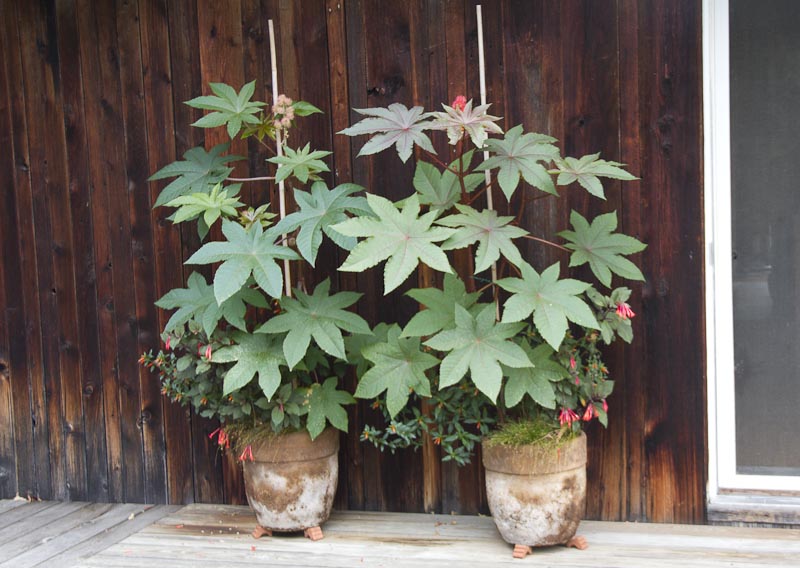
I’ve been buying these plants annually but this year, thanks to a friend, I learned that they are easy to start from seed. So that’s a few dollars I won’t be spending from now on.
3. Leaving sentimental attachments behind
Lantana features in a grouping of pots near the castor bean plants shown above. I’ve kept the lantana growing and blooming for six or seven years now, in part because lantana reminds me of my son and his family who live in Australia, where lantana will grow as big as a house if you let it, but also because I like the colours and the blooms that continue all summer long.
There are other plants on the same deck that I like — this pink one, for instance, that attracts bees….

I think this is a dark-leafed sweet potato vine, but I’ve had it for so many years that I can’t be sure.
and the electric grass that spills so nicely over the edge of the pot.
But while the individual flowers in this arrangement please me, the combination as a whole does not. Some years it may have been better, but the problem is the same: habit. It doesn’t take a lot of time or thought to put the same plants in the same pots, year after year, and that’s more or less what I’ve been doing.
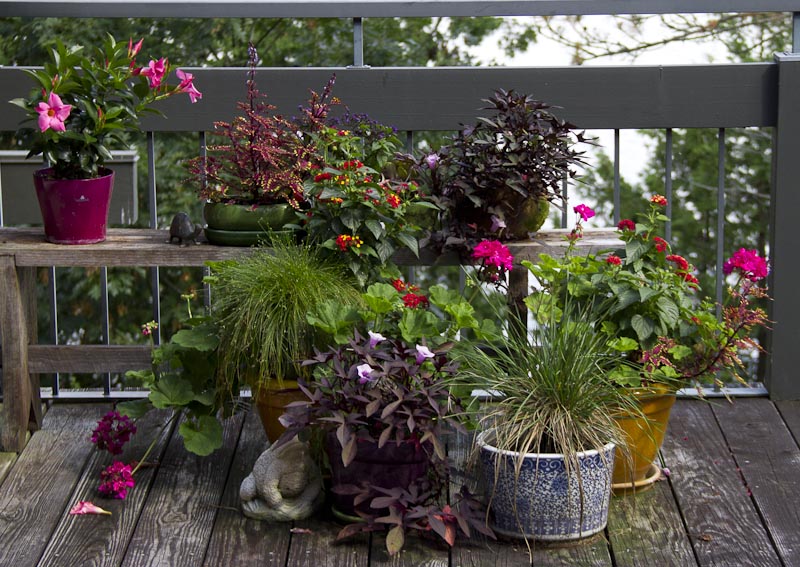
I overwintered almost all of these plants. The pink one on the far left was a freebie from the Garden Bloggers Fling, held this year in Toronto.
Solutions:
1. Reduce the number of different plants:
This year I simplified the planter by the kitchen door, using only coleus and a small hosta. I like the brightness in this dark area, particularly when set against the barnboard siding that on this part of the house is a weathered grey. I also like the simplicity that results from using two plants only.
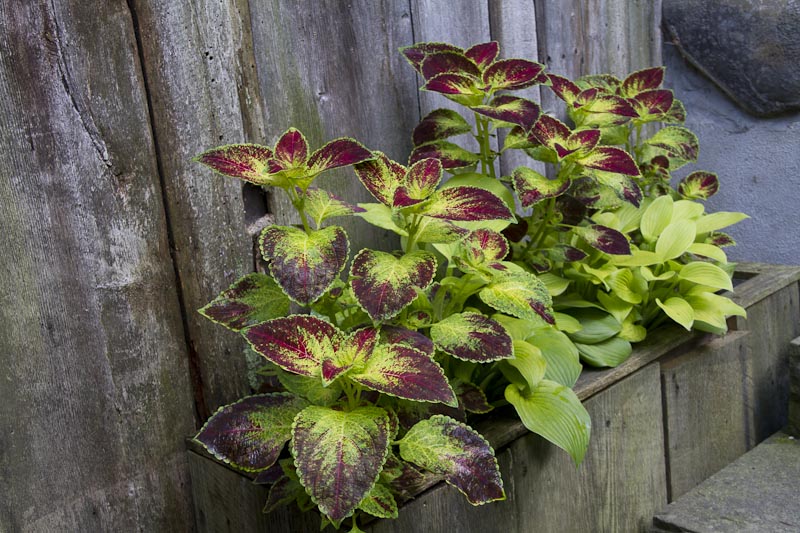
This planter is in shade for most of the day so the combination of coleus and hosta has worked well.
2. Consider colour and shape
This year I changed the planters on the dining room deck entirely, moving from the exuberance of orange and lime to a single shade of green. Boxwood with straight-trimmed edges repeats the lines of the house’s architecture and using a single plant adds a peaceful note to an area that is often noisy with children, grandchildren and friends.
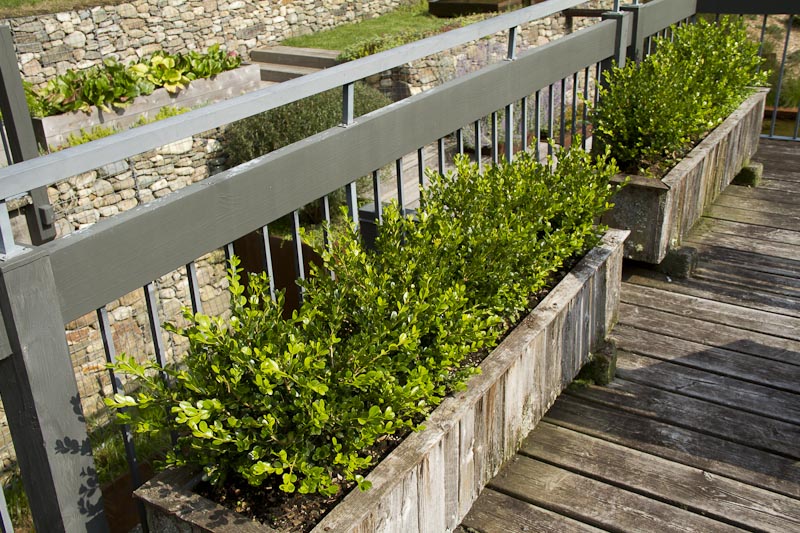
Boxwood fills two planters that are permanent features on the deck that leads from the kitchen and dining room.
3. Keep the overall goal in mind:
Buying new plants annually is expensive and overwintering is practical. I plan to heel the boxwood in over the winter and use them again next year. I will do the same with as many other plants as I can.
But where do I draw the line? Do I keep the mandevilla vines that climb the posts on the living room deck and bloom so prolifically, year after year? They don’t suit a strict interpretation of the house’s aesthetic, but I sure do love them.
4. Keep the planters, change the pots:
The planters on the dining room deck and by the kitchen door have been there since the house was built. They are clad with barnboard, as is the house itself, and using the same material means they suit the house automatically.
Not so for the living room deck. Here I’ve been using a combination of glazed pots which work well together but which don’t suit the house. An obvious solution, then, is to use pots that reflect a modernist style. I think this change will do wonders. Using pots with sleeker lines, for example, will allow me to keep the castor bean plants which I like.
5. Keep a pared down aesthetic in mind
Using fewer pots and leaving some of them empty may fill space visually without cluttering it up. Choosing architectural plants rather than cottage favourites will lead to cleaner lines.
Finding the right containers is a big part of the solution and I’ll keep you posted on my progress.
How do you plant your containers? Are you happy with the way they look? I welcome your thoughts and suggestions.


